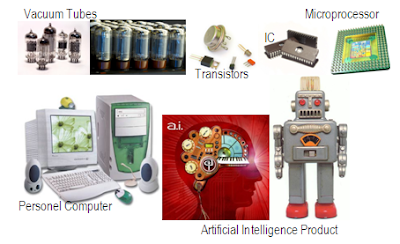1.1.1.1 Define ICT.
ICT is the technology required for information processing, in particular, the use electronics computers, communication devices and application software to convert, store, protect, process, transmit and retrieve information from anywhere, anytime.
1.1.1.2 Describe The Brief Evolution Of Computers
Fist Generation Computers ( 1940-1956)
During the first generation, computer were with vacuum tubes. Vacuum tube is an electronic tube is made of glass used as computer components to store and process data. The problems of vacuum tube are generates lots of heat that can damage computer and tube can burnt out frequently. ENIAC is first generation computer that contains weights of 30 tons, 18000 vacuum tubes, 30-50 foot space and 16000 watts of power.
Advantages of computers in this era : The using of vacuum tubes that can store and process data.
Second Generation Computers ( 1956-1963)
Transistors were use to replace vacuum tubes in computers. Transistors are small devices that transfer electronic signal across resistor. One transistor replaced the equivalent of 40 vacuum tubes. Transistors do not produced lots of heats and use less power. Transistors were faster, cheaper and smaller than vacuum tubes. The new computers were faster, smaller and more reliable than the first generation machines.
Advantages of computers in this era : The using of transistors was better than vacuum tubes.
Third Generation Computers ( 1964-1971)
In 1964, computer manufactures began replacing transistors with integrated circuits. An integrated circuits (IC) is acomplete electronic circuit on a small chip made of silicon. These computers were more reliable and compact than computers made with transistors, and they cost less to manufacture.
Advantages of computers in this era : Integrated circuits were reliable, compact and cheaper than transistors.
Fourth Generation Computers ( 1971-Present)
The microprocessor brought the fourth generation of computers, as thousands of integrated circuits were built onto a single silicon chip. What in the first generation filled an entire room could now fit in the palm of the hand.
The Intel 4004 chip, developed in 1971, located all the components of the computer - from the central processing unit and memory to input / output controls - on a single chip.
Advantages of computers in this era : Computers are 100 times smaller than ENIAC.
Fifth Generation Computers ( Present and Beyond)
Fifth generation computing devices, based on artificial intelligence, are still in development, thought there are some applications, such as voice recognation, that are being used today.
Tuesday, August 25, 2009
LA01 : ICT and Soceity
Posted by ICT HandyBook at 3:43 AM 0 comments
Monday, August 24, 2009
Sunday, August 23, 2009
1.1.2.1 List The Usage Of ICT In Everyday Life.
Education
- Teacher use computers to research for teaching materials, participate in online forum and online conferences.
- Students use computers as reference tools for looking information in the internet.
- Researchers use computer to collect and process data.
- School administrators use computers for administrative purpose to make sure that entire operations run smoothly.
Banking
- Bank administrators can control the entire banking system and banking activities such as reconciliations, inter-branch transactions (IBT) and telegraphic transfer.
- Customers can make any transaction at 24 hours service centers.
- Businessman can save their time by using online services offered by banks. They also can access company accounts for loan applications, business transactions and update their cash flow anytime and anywhere.
Industry
- To facilitate production planning and control systems.
- To assist manufacturing process by using CAM.
- To help workers operate machine. Robots are used to take dangerous jobs.
- To help researchers analyze and collect research data for future references.
- To help administrators to oversee and control entire operations in the factory.
E-Commerce
- To make buying and selling activities faster and more efficient through internet.
- To connect online the customers with suppliers to purchase product. This method can save time and cost without using a broker and without go to any outlets.
- To help suppliers to keep track of their transaction. All products are bar coded and can be read by the bar code scanner to help in determining prices and managing inventory.
- To help employees to communicate to their customers for any requires and to get the latest updates inventory to be informed to the customers.
1.1.2.2 State The Differences Between COMPUTERISED and NON-COMPUTERISED System.
Computerised
- All banking activities are done by using computer system.
Non-Computerised
- All banking activities were done manually.
Positive Impact
- Faster Communication Speed. With the internet, news or messages are sent via e-mail to anyone efficiently. With the capability of broadband and speed of connection on the internet, any information can be travel faster.
- Lower Communication cost. With the internet, we do not have to pay any basic services provided by in the internet. Furthermore, the cost of the connection to the internet relatively cheap.
- People can share opinions and information through discussion groups and forums through internet.
- Paperless environment. Information can be stored and retrieved through the digital mediun instead of paper.
- Information and communication can be border less through internet. By using internet, people all around the world can be connected through each other.
Negative Impact
- Border less information at time can be negative because it courage people to access pornography and violence web sites. It can cause low moral values. It also can created problems such as gambling, information theft and fraud.
- Computer can harm users if they use for long hours frequently.
Posted by ICT HandyBook at 10:28 PM 0 comments
